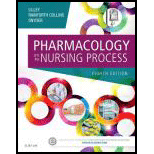
To discuss:
The infectious process associated with helminthic infections, protozoal infections, and malarial infections.
Concept introduction:
Malaria is the most important protozoal disease (in terms of mortality and morbidity). Malaria is a deadly disease that is caused by Plasmodium (protozoan
Helminthic infections are caused by parasitic worms like ascardia, liver fluke, and tapeworm.
Explanation of Solution
The infectious process associated with helminthic infections, protozoal infections, and malarial infections are as follows:
Malarial infections:
Malarial transmission occurs by the bite of an infested mosquito (female anopheline). It is also caused congenitally (mother to fetus) and by blood transfusions.
The life cycle of Plasmodium species involves two stages. They are sexual cycle (inside the mosquito) and asexual cycle (occurs in the human being). The asexual cycle consists of two phases, which includes the exoerythrocytic phase (other than erythrocytes) and erythrocytic phase (occurs inside the erythrocyte) or blood phase.
An anopheles (infected) mosquito acts as a carrier to transport the parasite into the human. The liver is the place where the parasite gets matured and enters into the blood and starts breaking the red blood cells.
Helminthic infections:
Helminthic infections are considered as a worldwide problem. It is also called as worm infections. Cestodes (tapeworm), Nematodes (roundworms), Platyhelminthes (
Other protozoal infections:
Protozoal infections include Giardiasis (causative agent is Giardia lamblia), Toxoplasmosis (causative agent is Toxoplasma gondii), Amebiasis (causative agent is Entamoebahistolytica), and Trichomoniasis (causative agent is Trichomonas vaginalis). They are transmitted by sexual contact (person to person), contaminated food or water ingestion, bite of an insect (direct handling of the parasite). They initially infect residues in the human liver and slowly travel to various parts of the body like the liver.
The infectious process associated with helminthic infections, protozoal infections, and malarial infections are discussed.
Want to see more full solutions like this?
Chapter 43 Solutions
Pharmacology and the Nursing Process, 8e
- true or false dark skinned infants should be screened for vitamin D levelsarrow_forwardtrue or false any practice employee is authorized to and should communicate collection guidelines with practice?arrow_forwardrtrue or false equesting a listing of specific creditreferences during patient intake os an acceptable business practice?arrow_forward
- give an overview on the respiratory assessmentarrow_forwardexplain an abdominal exam?arrow_forwardDiscuss β -Lactam antibiotics under the following subheadings Classifications of penicillins Classification of Cephalosporins General Mechanism of Actions Clinical Indications of penicillins and cephalosporins Adverse effects of β-lactamsarrow_forward
- a. Define neoplasm b. Differentiate between benign and malignant tumours c. Describe the molecular basis of cancerarrow_forwarddifferentiate the extra heart sounds S3,S4, murmurs and gallopsarrow_forward• Define shock and list types of shock • Discuss pathogenesis of septic shock. • Enumerate the stages of shock. • Define oedema and describe the pathophysiologic mechanisms of oedema with examples.arrow_forward
- Discuss Hypertension under the following headings: Definition Diagnosis Non-pharmacological intervention Drugs Classification Management of a Hypertensive emergencyarrow_forwardExplain how the answer could be 2 or 1.8 WITHOUT changing the questionarrow_forwardoverview of the neurological system, cranial nerves and what part of the body it innervatesarrow_forward
 Phlebotomy EssentialsNursingISBN:9781451194524Author:Ruth McCall, Cathee M. Tankersley MT(ASCP)Publisher:JONES+BARTLETT PUBLISHERS, INC.
Phlebotomy EssentialsNursingISBN:9781451194524Author:Ruth McCall, Cathee M. Tankersley MT(ASCP)Publisher:JONES+BARTLETT PUBLISHERS, INC. Gould's Pathophysiology for the Health Profession...NursingISBN:9780323414425Author:Robert J Hubert BSPublisher:Saunders
Gould's Pathophysiology for the Health Profession...NursingISBN:9780323414425Author:Robert J Hubert BSPublisher:Saunders Fundamentals Of NursingNursingISBN:9781496362179Author:Taylor, Carol (carol R.), LYNN, Pamela (pamela Barbara), Bartlett, Jennifer L.Publisher:Wolters Kluwer,
Fundamentals Of NursingNursingISBN:9781496362179Author:Taylor, Carol (carol R.), LYNN, Pamela (pamela Barbara), Bartlett, Jennifer L.Publisher:Wolters Kluwer, Fundamentals of Nursing, 9eNursingISBN:9780323327404Author:Patricia A. Potter RN MSN PhD FAAN, Anne Griffin Perry RN EdD FAAN, Patricia Stockert RN BSN MS PhD, Amy Hall RN BSN MS PhD CNEPublisher:Elsevier Science
Fundamentals of Nursing, 9eNursingISBN:9780323327404Author:Patricia A. Potter RN MSN PhD FAAN, Anne Griffin Perry RN EdD FAAN, Patricia Stockert RN BSN MS PhD, Amy Hall RN BSN MS PhD CNEPublisher:Elsevier Science Study Guide for Gould's Pathophysiology for the H...NursingISBN:9780323414142Author:Hubert BS, Robert J; VanMeter PhD, Karin C.Publisher:Saunders
Study Guide for Gould's Pathophysiology for the H...NursingISBN:9780323414142Author:Hubert BS, Robert J; VanMeter PhD, Karin C.Publisher:Saunders Issues and Ethics in the Helping Professions (Min...NursingISBN:9781337406291Author:Gerald Corey, Marianne Schneider Corey, Cindy CoreyPublisher:Cengage Learning
Issues and Ethics in the Helping Professions (Min...NursingISBN:9781337406291Author:Gerald Corey, Marianne Schneider Corey, Cindy CoreyPublisher:Cengage Learning





